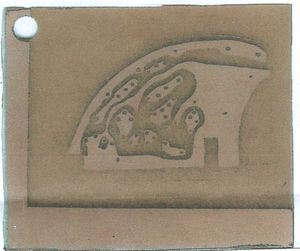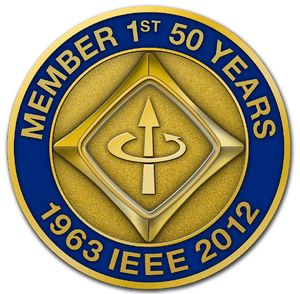First-Hand:It's a Small World
It's a Small World

Submitted by Samuel Colodny
At the end of May 1942, Samuel Colodny, that's me, was graduated from the Engineering Department of Catholic University in Washington, DC as Bachelor of Science in Electrical Engineering, with a Magna Cum Laude.
With an interest in railroads, I was considering taking a position in Pittsburgh where I might work on Traction Power applications. However, other events pushed and pulled me into a different decision. They were:
- My girl-friend insisted that Westinghouse at Pittsburgh was much farther away from Washington, DC, where our families lived, than Philadelphia, even though the MA & PA RR (Maryland and Pennsylvania Railroad) at that time provided passenger service between DC and Pittsburgh. ( We used the DC to Phila portion of the Pennsylvania RR many times before we were married in Nov. 1942.) And also:
- Philco Corp. was told by the Navy Department that they could not be given additional contracts for development unless their technical staff was radically increased. Whereupon Philco assigned some of their expert salesmen to visit graduating engineers at their respective schools and entice them to work in a new field : Electronics. As a result of this campaign, Philco hired 81 newly minted engineers, and provided a summer course for extending their knowledge in this extension of Electrical Engineering. I was one of those drawn into this program, worked for Philco for 18 years, and have never regretted it.
Among the various projects that Philco produced for the Navy and other military departments near the start of World War II, there was a need for the pilots of our airplanes to identify whether the craft they were pursuing was friend or foe. This occurred because some of the planes, newly made, went to both sides. Others, from our side had been captured and then used by the enemy; and vice versa. This project was to develop a Transponder (Receiver + Responder), named IFF (ldentifty Friend or Foe). It was to be installed in the tail of each plane to radiate a signal back to the pursuer's RADAR, at the same frequency but slightly delayed. This was my first project at Philco, under the supervision of Tim McCoy. I worked on the coder, which provided that for each for each received pulse of the RADAR, after a fixed initial delay, a selectable series of dots and dashes would be displayed on the pursuer's RADAR display return Signal from the pursued friendly plane's RADAR reflection. I didn't expect that much later I would meet a maintainer of the equipment.
Operationally, the retransmitted code was changed daily in the IFF. Obviously, if there was no code returned, or if the code was wrong for that day, then probably the target was an enemy. I also worked on the 30 Mhz Intermediate frequency vacuum-tube amplifier for the overall IFF equipment. When the prototype was completed and performed satisfactorily in tests, the drawings for every part were completed along with the Parts Lists and Test Procedures. That package of information was given, by one of the Armed services, to other firms under contracts to manufacture the IFF in appreciable quantities.
Time Passes
I worked for Philco from 1942 to 1960, leaving as development work seemed to be fading away, and before Ford Corp took over, inappropriately using automobile-oriented Quality-Control systems on electronic assembly minor rejects. In addition to varied military equipments developed, I.made the first transistor TV incremental tuner using transistors (possibly? type LM102) supplied by Philco's subsidiary, Lansdale Tube Corp. Attached is a copy of that little artwork.
Then I worked for Jetronic Industries in Philadelphia for 1 year.
Afterwards I worked 3 years for Elion Instruments in Bristol, PA. which was a split-off of RCA. Dr. Herbert Elion conceived of several high-level research instruments, wanting to develop them. But RCA management declined funding such projects. He was allowed to separate his concepts and himself from RCA and form his company. I assisted Physicist Lou Shapiro in building his project The Microprobe, which provided for bombarding a sample of material with electrons in a tight beam, and accurately measuring emitted particles' directions and intensities. One of these was delivered, as I remember, to the Physics Dept. of Washington University, at St. Louis. Next, using clues Lou supplied, I planned how to space two Helmholtz coils to produce the maximum volume of uniform magnetic field, designed the coils, the sweeping 'DC' power supply, and the auxiliary RF field generator to make a Spin Resonance Equipment. This was delivered to a Dr. Love at the Physics Dept of Rutgers University at New Brunswick, New Jersey.
American Electronic Laboratories (AEL) was organized by Leon Reibman, with whom I had worked at Philco. I worked for AEL for 15 years on a great variety of projects largely for the military.
One Project, possibly the MLQ30, was near the end of the war effort in Viet Nam. Its first part consisted of six Signal Corp receivers which were manually scanned to find enemy communication channels. When such were found, each could issue a jamming signal around that channel, but at low power. The second part had 6 Power Amplifiers, a Multiplexer, and a Combination Receiver/Transmit Antenna to join their outputs and broadcast the jamming signal. A 3rd part was the control system which repeatedly sampled, for 10% of the time, the channels selected by the operator to be jammed. Because the sample time was predictable, I proposed that the timer have large time-jitter to make its occurrence unusable by the jammee; this was approved by the military. The Power Amplifiers has mercury switches to connect each Power Amplifier to the Antenna with the correct timing. However, because all of the system described was mounted on a two-wheeled trailer along with a gasoline-driven generator, and the mercury switches must be very close to a vertical mounting position for safe operation, a leveling detection device was included. The control panel, taking my suggestion, shows a brilliant red light, labeled 'TILT' (as in Pin-ball machines), when the equipment is not properly level, nor will it power up. About one month after 3 such equipments were delivered, Electronic News had an article about a new communications jammer that was now extensively used against the Viet Cong, and had totally wiped out their operational communications! (propaganda??)
During several school years before May 1957, I again attended Evening Graduate School at the University of Pennsylvania, working toward a Doctorate of Science in Electrical Engineering (PhD), taking optional advanced courses in Mathematics and Theoretical Physics. I was supposed to get my degree in 1956, but my father passed away and an extra years was allowed. Somehow, I was frightened by the language exam requirement, French by my selection, and neglected to sign up by the last date, this means I have no PhD!!
Project TOCOM, in the pre-satellite period, was built for countries too mountainous for reasonable TV antenna heights. For Nigeria and South Korea, we designed and delivered low-weight TV Transmitters which were installed in a tethered blimp, called aerostats. To minimize weight in both the aerostat and its tether, the power was sent up at high frequency, possibly at 400 Hz, and at several kilovolts; the only transformer above was for the vacuum-tube filaments.
Then came a shortage of deveiopmental electronic work. I became a part time employee as a Licensed Engineering Consultant for AEL for about a year.
An engineer friend(M) of a friend(F) knew of me at a time when RCA was advertising to its employees that $1000 was the prize for identifying a suitable new electronics engineering employee. He identified me and got the prize in 1981. But I got the better prize: I was interviewed at RCA Astro and gladly accepted a position, remaining with them for 10 years, designing electronic components and then communication systems for satellites, for both businesses and the military, and during which time it became a General Electric facility.
I Retire at Age 71, and More Time Passes
My wife and I gave up our long empty nest in Langhorne, Pennsylvania and move to Salt Lake City, Utah into the house my daughter#l and her husband have just rebuilt. We're now with family; two great-grandsons and their parents, (including a granddaughter), also live nearby. We are closer to Los Angeles, CA, where another granddaughter, her husband, and two greatgranddaughters live.
For variety of contacts, my wife and I go to the Mt. Olympus Senior Center and talk to other retirees, some not yet 92 as I am. Out of one of these conversations I find out that one person is Mr. Jack Stowers, an Air Force (Retired) Major. At Wright Air Force Base (now Wright-Patterson), in 1942, he was aSSigned the job of visiting Philco and learning how to maintain the SCR595, as the IFF was designated by the Signal Corps. Although I did not meet him then, it is pleasant to have met him recently in our small world.
